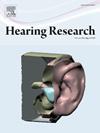TRPA1 deficiency affects cochlear potentials days after noise exposure
IF 2.5
2区 医学
Q1 AUDIOLOGY & SPEECH-LANGUAGE PATHOLOGY
引用次数: 0
Abstract
TRPA1 channels are master sensors of tissue damage. We recently showed that, after acoustic trauma, TRPA1 activation in cochlear supporting cells regulates hearing sensitivity and is a component of the temporary threshold shift. In the neonate organ of Corti, TRPA1 activation in the Hensen’s cells leads to prolonged calcium responses that propagate across the organ of Corti and cause long-lasting tissue displacements. In the adult cochlea, such tissue shape changes would be expected to affect the geometry and/or stiffness of the cochlear partition and, consequently, cochlear amplification. However, we still lack direct evidence of TRPA1-mediated changes to cochlear mechanics in adult mice. Here, we extracted remote cochlear microphonic (rCM) and summating potential (SP) data from auditory brainstem responses (ABRs) to evaluate noise-induced changes to these cochlear potentials that depend on TRPA1 signaling. Our results show significant differences in SP amplitudes of click-evoked ABRs between Trpa1–/– mice and wild-type littermates. However, five days after noise exposure, the SP differences were no longer observed likely due to an overall reduction in rCM amplitudes in the Trpa1–/– mice which was not seen in wild-type littermates. In addition, mice exhibited a direct current (DC) shift in the rCM elicited by an 8 kHz tone burst as the sound intensity increased, which was delayed in Trpa1–/– mice. Our results indicate that TRPA1 signaling after loud sound stimulation triggers changes in the cochlear transducer, but the specific mechanisms underlying these changes and whether they minimize noise-induced tissue damage remain to be elucidated.
TRPA1缺乏会影响噪声暴露后几天的耳蜗电位
TRPA1通道是组织损伤的主要传感器。我们最近发现,在声创伤后,耳蜗支持细胞中的TRPA1激活调节听力敏感性,是暂时阈值移位的一个组成部分。在Corti的新生儿器官中,Hensen细胞中的TRPA1激活导致延长的钙反应,这种反应在Corti的整个器官中传播,并导致长期的组织移位。在成人耳蜗中,这种组织形状的改变预计会影响耳蜗隔板的几何形状和/或硬度,从而影响耳蜗放大。然而,我们仍然缺乏trpa1介导的成年小鼠耳蜗力学变化的直接证据。在这里,我们从听觉脑干反应(ABRs)中提取远程耳蜗麦克风(rCM)和求和电位(SP)数据,以评估噪声诱导的依赖TRPA1信号的这些耳蜗电位的变化。我们的研究结果显示,Trpa1 - / -小鼠和野生型幼崽之间点击诱发ABRs的SP振幅存在显著差异。然而,在噪声暴露5天后,SP差异不再被观察到,这可能是由于Trpa1 - / -小鼠的rCM振幅总体下降,而这在野生型幼崽中没有观察到。此外,在Trpa1 - / -小鼠中,随着声强的增加,小鼠的rCM出现了由8 kHz音调爆发引起的直流电位移(DC),这种位移在Trpa1 - / -小鼠中被延迟。我们的研究结果表明,响亮的声音刺激后TRPA1信号会触发耳蜗换能器的变化,但这些变化的具体机制以及它们是否能最大限度地减少噪音引起的组织损伤仍有待阐明。
本文章由计算机程序翻译,如有差异,请以英文原文为准。
求助全文
约1分钟内获得全文
求助全文
来源期刊

Hearing Research
医学-耳鼻喉科学
CiteScore
5.30
自引率
14.30%
发文量
163
审稿时长
75 days
期刊介绍:
The aim of the journal is to provide a forum for papers concerned with basic peripheral and central auditory mechanisms. Emphasis is on experimental and clinical studies, but theoretical and methodological papers will also be considered. The journal publishes original research papers, review and mini- review articles, rapid communications, method/protocol and perspective articles.
Papers submitted should deal with auditory anatomy, physiology, psychophysics, imaging, modeling and behavioural studies in animals and humans, as well as hearing aids and cochlear implants. Papers dealing with the vestibular system are also considered for publication. Papers on comparative aspects of hearing and on effects of drugs and environmental contaminants on hearing function will also be considered. Clinical papers will be accepted when they contribute to the understanding of normal and pathological hearing functions.
 求助内容:
求助内容: 应助结果提醒方式:
应助结果提醒方式:


